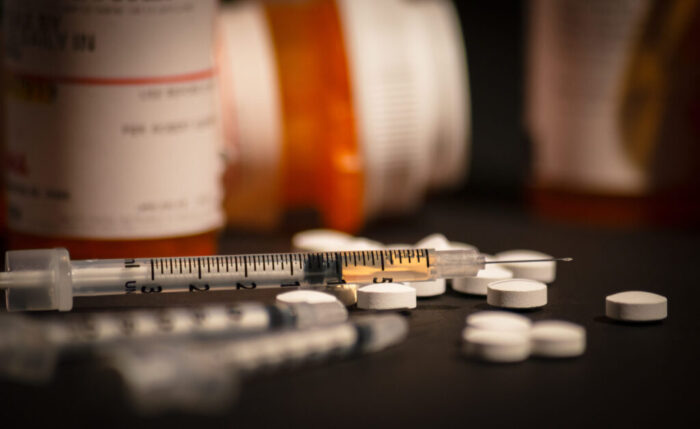An injectable drug is loaded into a syringe while prescription medication is strewn about haphazardly. Photo by Darwin Brandis/iStock Getty Images Plus
Baltimore officials this week laid out plans for how they intend to distribute the $252.5 million the city has received – so far – in settlements with pharmacies and drug companies over their role in the opioid crisis.
Mayor Brandon Scott signed an executive order Thursday creating an advisory board that will determine how to distribute the funds to help those city residents struggling with opioid addictions. The order also calls for the money to go toward programs for harm reduction, for treatment and recovery, education on opioid use and prevention of new opioid use.
Funding will go to both government and community-based programs: Scott said that $20 million will go to the city’s health department to continue work combating the opioid crisis, and $42 million had already been allocated to a dozen organizations in Baltimore fighting substance use disorders.
“We cannot undue the harm that has been done, or bring back the lives that we lost,” Scott said. “We can, and we are taking decisive actions to address this epidemic and prevent further loss of life, and repair the harm done to our community.”
His announcement came just days before International Overdose Awareness Day, on Aug. 31, and he declared that the city would officially recognize the awareness day Thursday.
Scott noted that in the first seven months of 2024, Baltimore residents accounted for 44% of overdose deaths in Maryland, even though the city represents just 9% of the state’s population.
“Baltimore has been disproportionally impacted by the scourge of addiction for longer than I’ve been alive,” said the 40-year-old Scott. “The dark, tangled relationship that our city, and far too many of our residents, have grappled with stems directly back to intentional disinvestment and systemic racism.”
Baltimore has passed on the opportunity to join other governments in lawsuits against pharmaceutical companies, opting instead to take action on its own. The risks is higher by going it alone, but so are the potential rewards and so far that bet appears to be paying off.
Scott said that with the three settlements the city has agreed to so far, is has already recovered more it could have received under global settlements between drug makers and state and local governments. He said the city is still in litigation with five other pharmacies for their alleged role in the crisis by flooding the market with prescription opioids, but he is confident.
Baltimore wins another $45 million from a drug company in opioid litigation
“We still have fights to win against the largest companies of the batch. And as we continue negotiating and lock towards our trial date of September 16th, we’re confident that we’ll win those cases too,” Scott said.
The executive order signed Thursday sets up a framework for allocation of current and future settlement proceeds, establishing the Baltimore City Opioid Restitution Fund and creating a Restitution Advisory Board.
The advisory board will include at least four city residents with lived experience with substance use, social workers, public health advisers, a designee from a harm reduction center, two members of the Baltimore City Council, and the CEO of the local behavioral health authority. The board will also have three non-voting members: the executive director or a mayoral designee, the city health commissioner or a designee, and the fire chief or a designee.
The executive order creates the positions of executive director of overdose response and an opioid restitution program manager in the mayor’s office. Finally, it requires the city to create a comprehensive overdose reduction strategy at least every two years. The plan is required to have community input, including from those who struggle with substance use disorders.
“This executive order makes clear that we will do everything in our power to save lives and help our residents heal,” Scott said. “Part of what is outlined here includes direct community engagement from town halls, focus groups and online surveys so all residents, not just the few selected for the advisory board, will be able to have their voices heard in this process and be able to tell us and their neighbors where they’d like to see this money going and what would make a difference in their lives and in the lives of their families.”

